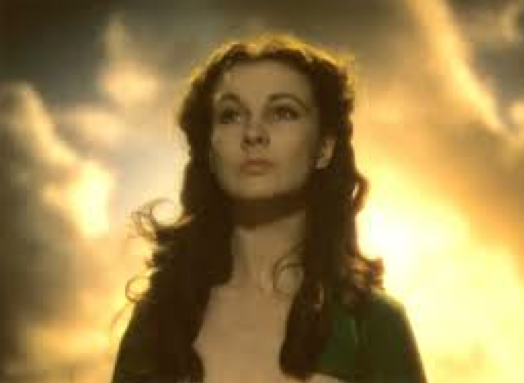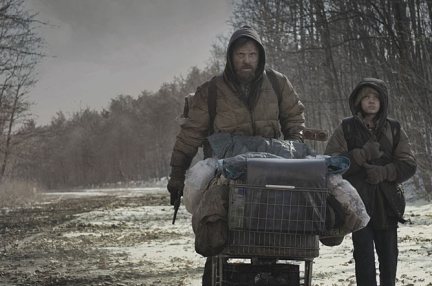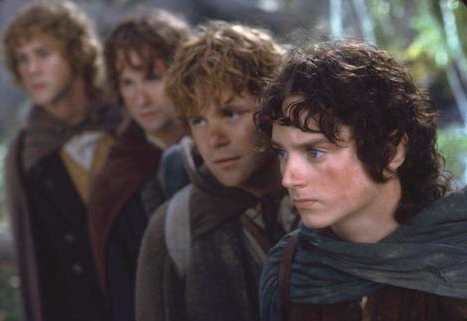Everybody Arcs! How to Use Emotional Growth to Propel the Story and Capture the Reader

Because the Scarletts of the world get THINGS DONE….
I’ve heard people say some books (or genres) are plot-driven and others are character-driven. My POV? This is a fallacy. All good books are character-driven and plot is what makes that possible. Characters have to make us give a hoot about the plot. If we don’t like or empathize with the characters, we don’t care about their problems.
Conversely, plot is the delivery mechanism and crucible for character (even in literary fiction). Characters can only be as strong as the opposition they face. Weak problems=weak characters. In a nutshell, character and plot can’t be easily separated.
For instance, in the Pulitzer-Winning The Road, the plot is simple. Man and Boy must make it to the ocean. Yet, since this piece is literary, the plot goal is subordinate to character goal.
It is less important that Man and Boy make it to the ocean than how they make it to the ocean. The world has been obliterated, killing every living thing other than humans. Many have returned to the animal state, resorting to cannibalism to survive. The question in The Road is less “Will they make it to the ocean?” and more “How will they make it to the ocean?” If they resort to snacking on people, they fail.

The Road
But I will say that while plot is great, characters are what (who) we remember. We have to be able to empathize. We want to love them, hate them, root for them and watch them fail, then overcome that failure. As the late Blake Snyder said, “Everybody arcs!”
Often, this is the trick with series and why early books generally are more popular. Once our main character evolves, we are left with three choices:
1) Have plot create a new flaw in the protagonist.
2) Peel back another flaw that was already there, but hidden by a more visible flaw.
3) Protagonist can serve as a static character who drives growth in other characters.
Whether we are writing a standalone or a series, character growth is pivotal to good writing. I believe one of the reasons humans are a story people is that we fear change. Often, we see our own flaws and have NO IDEA how to correct them, how to get unstuck. We can feel defeated. Yet, through narrative, we watch protagonists become heroes and, unlike life, there’s full resolution. We can see some slice of ourselves in stories and it helps us change or at least maintain hope that change is possible.
Tools
I highly, highly recommend Angela Ackerman and Becca Puglisi’s Negative Trait Thesaurus and Positive Trait Thesaurus (and add in The Emotion Thesaurus to assist in execution). These books are awesome at helping us see how characters should grow organically. What I love about these books is Angela and Becca show positives of the negatives and negatives of the positives.
For instance, a flaky character can be annoying, unreliable and unpredictable. BUT since this character is unpredictable, she can be very useful because she’s unconventional. She can add comic relief (Phoebe Buffet from Friends) or even tension (Riggs from Lethal Weapon).
Both thesauri show behaviors, attitudes and examples which can make writing life MUCH easier. The Emotion Thesaurus gives us ways to show not tell to express these traits and keeps us from beating up the same descriptions (hearts hammering, hearts beating, hearts thumping, etc.)
How I Use These FABULOUS TOOLS
There is no one right way to write a book. What I did was read a lot of methods, tried them, took what worked and what didn’t and then cobbled my own. But here’s a peek into MY process and the process I encourage students to begin with.
Since I’m writing a trilogy, I needed to look at who my character was in Book One. In Book One, Romi is very loyal and innocent which is ultimately what lands her in trouble. She blindly trusts because she sees only the good in others and ignores or writes off red flags. By the end of Book One, she’s been through a MAJOR crucible and crawled through hell. To survive the Big Boss Battle, she has to kill or be killed. The person she has to kill is a person she cares about and trusted.
My pitch for Book One is Legally Blonde meets Killing Floor.
And my protagonist is a person who, at the beginning of the story, couldn’t step on a bug let alone take a human life. This final action changes her irreparably and damages her innocence.
So, in Book One, my protagonist evolves from Green Pea Pollyanna to Hero Willing to Do What It Takes to Do the Right Thing.
Ah, but doing the right thing has a price. In Book Two, I can’t have her be the same person as Book One or she isn’t believable. Book Two, she’s flipped to the other side of the loyal-trusting-innocent coin and is two steps away from wearing a tin foil hat. Now she questions everything and can never relax. Everybody lies, is her motto. She no longer talks to just anyone, questions everything and is controlling and isolated (but for very good and sympathetic reasons).
Yet, let’s glance at The Positive Trait Thesaurus and I’ll shorten for brevity’s sake.
Book One: Romi Lachlann
Positive: Innocent characters are pure and trusting. They take people at face value and want to believe the good. Easy characters to like and protect.
Negative: In their determination to only see the good, innocent characters may not view the world and other people as they really are, which puts them at a disadvantage.
When we look at this character’s personality, plotting becomes easier. We can also clearly see her Achilles Heel. She needs to be betrayed by someone she trusts blindly and be able to act in a way that is completely contrary to her nature. Also, by knowing who she is (in the beginning) it’s simpler to see who to cast as the antagonist and even allies. She needs allies who challenge her willingness to swallow whatever story she’s fed and help her toughen up.
The core antagonist has to be someone she never sees coming.
When we glance at The Negative Trait Thesaurus, we see that the dark side of Innocent is Childish.
Positive: Innocent and naive. Like children, they are teachable and adapt quickly.
We can use this positive attribute for the protagonist when we look at the proposed solution in The Negative Trait Thesaurus.
Overcoming The Trait as a Major Flaw: A character can defeat his immaturity by growing up. For some, this will mean encountering trials that force them to mature in a short period of time. Other characters will have to face past demons that are keeping them enslaved in this childish state.
This gives me guideposts as to what Book One must accomplish. Romi is tossed head-first into BIG TROUBLE and most of that trouble involves facing a past she believed she left behind when she ran away from home. The story problem forces her to go back to the place she vowed she’d never return.
I could leave my first novel alone. It’s complete. All books (even in a series) should be able to stand alone.
Romi arcs from innocent and blindly trusting person to a determined fighter. But, I wanted the challenge of trying a trilogy, so I have to repeat the process all over again. What is the opposite of Innocent? Resourceful. What is the dark side of resourceful? Paranoid.
And thus I repeat the process. Who is she in the beginning? Who do I need her to grow to be by the end? She can’t live in a hole hiding and terrified of dying. Something has to push her past her fears to face that she’s regressed into an unhealthy existence. Something has to make her rise above her fear and restore her faith.
There will be residue of that innocent-loyal person, but it now has a hardened shell as a defense mechanism. The “thing” that lures her out of hiding is likely tethered to her core nature. Being uber-paranoid isn’t who she truly is. It’s a coping mechanism, a protection.
Remember, in the beginning, I said one plot problem can create a new character problem. Like cogs in a wheel these arcs propel narrative and drive growth and change.
Also, remember that no character is only ONE of these attributes. Strong characters are a unique blending or we end up with caricatures. An innocent character can also be loyal and funny (Elle Woods in Legally Blonde) or they can be isolated and fearful (Edward Scissorhands).
Favorite Story Example

The Lord of the Rings
I love Lord of the Rings probably more than is healthy. I loved the arc of the Hobbits. Sauron never saw Hobbits as particularly useful (they didn’t get a ring) and he never perceived them as any sort of threat. Yet, it is their innocence that becomes Sauron’s ultimate undoing.
Unlike the other races, Hobbits are not as susceptible to the Ring of Power’s sway because of their innocence and inherent goodness. But, in the first book (or movie) their naiveté nearly gets them and all their allies killed.
***Um, cooking bacon on a mountain while EVIL DEAD KINGS are chasing them and trying to KILL them?
The Hobbits must toughen up and lose some of that innocence…but not all of it. If they lose all of it, the Ring of Power will never be destroyed and Sauron wins. Yet, my favorite scene in all cinematic history (which makes me cry EVERY time) is the end of Return of the King. We see the once childlike Hobbits around a pub table, silent, sharing a drink and we see what they sacrificed to not only save the world, but preserve the inherent goodness of their people.
While the other Hobbits dance and laugh and drink in the background, these warriors are quiet and somber. They likely have PTSD and are trying to recapture what they’ve lost, but can never regain. They will never again see the world as they did before that first day leaving The Shire. It is tragic and beautiful all in the span of a few moments.
I hope this gives you some new ideas of how to create dimensional characters. When we know who our characters are (protagonists and antagonists) and where we need them to be/grow, plotting is far simpler.
What are your thoughts? Have you used these books? Maybe used them in a different way? What are some of your favorite character arcs? Do you dislike super-perfect characters?
To prove it and show my love, for the month of APRIL, everyone who leaves a comment I will put your name in a hat. If you comment and link back to my blog on your blog, you get your name in the hat twice. What do you win? The unvarnished truth from yours truly. I will pick a winner once a month and it will be a critique of the first 20 pages of your novel, or your query letter, or your synopsis (5 pages or less).
If you want more help with plot problems, antagonists, structure, beginnings, then I have TWO classes coming up to help you!
Upcoming Classes
BOTH CLASSES COME WITH HANDOUTS AND FREE RECORDING.
A seasoned editor can tell a lot about your book with only five pages. Learn to hook hard and hook early. I am running the Your First Five Pages Class. Use WANA10 for $10 off. This is the perfect class for diagnosing bigger story issues or even getting a work agent-ready in time for conference season. This class is April 25th 6:00-8:30 PM NYC Time. Gold Level is available if you want me to critique your 5 pages.
Also, if you are struggling with plot or have a book that seems to be in the Never-Ending Hole of Chasing Your Tail or maybe you’d like to learn how to plot a series, I am also teaching my ever-popular Understanding the Antagonist Class on May 10th from NOON to 2:00 P.M. (A SATURDAY). This is a fabulous class for understanding all the different types of antagonists and how to use them to maintain and increase story tension. Remember, a story is only as strong as its problem ;) . Again, use WANA10 for $10 off.





